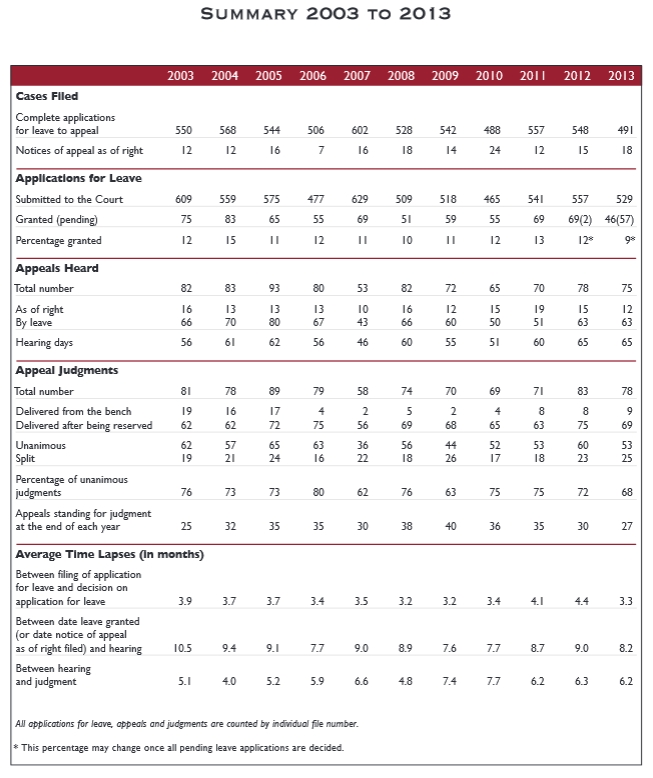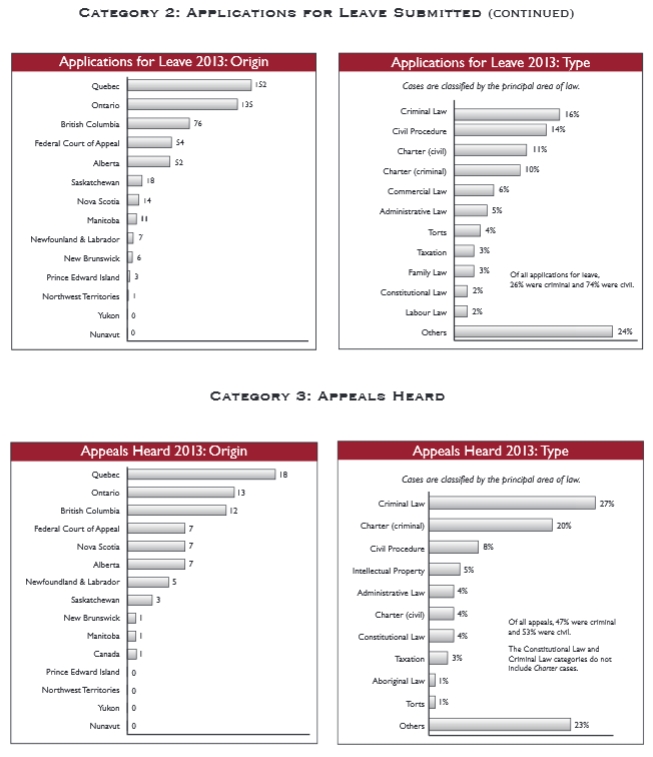The Supreme Court of Canada typically deals in nuance — language, logic, conceptual frameworks — so a
report that boils down court activities to cold calculus offers an interesting take.

The report, released last Friday, breaks down SCC work over the past decade, from 2003 through 2013. It provides detailed statistics on: number of applications filed; applications submitted and granted; judgments issues; and the average time between each stage of the process.
The numbers don’t show any startling revelations, but a close look does reveal a subtle but fascinating trend over the years.
Increasingly, it seems the Supreme Court has been taking on more complex, time-consuming cases — and particularly those dealing with serious criminal and Constitutional matters. As a result, this has left the court with less time to deal with other issues (such as appeals related to civil procedure).
This finding can be seen throughout the report, although the court makes no point of commenting on this trend (again, strictly numbers; no analysis).
Take the following three stats, for instance:
1. The number of mandatory appeals filed “as of right,” such as government references and significant criminal matters, are on the rise. (From 2003 to 2007, an annual average of 12.6 of these appeals were filed, compared to 16.6 for the most recent five-year period.)
2. Given the same periods, the number of appeals heard every year has been gradually falling (78.2; 72).
3. Despite the lower number of appeals, the number of hearing days is rising (56.2; 59.2)
So fewer appeals, more hearing days, and more references and “as of right” cases.” In the simplest terms, it seems the court has chosen more quality and less quantity.
The conclusion is further supported by a second section that breaks down the origins of appeals.

Last year, 18 of 75 appeals heard (or 24 per cent) originated from Quebec, where the province’s Civil Code and unique place within the federation often raise issues that can only be sorted out by the top court. (By comparison, only 17 per cent of appeals heard came from Ontario, with almost twice the population.)
Or take a look at the breakdown of appeals by type: while criminal law, constitutional, and Charter appeals made up 39 per cent of submissions in 2013, they comprised a whopping 55 per cent appeals heard last year.
Appeals related to civil procedure, meanwhile, got short shrift. (These cases comprised 14 per cent of submissions, but only eight per cent of appeals heard.)
Finally, and perhaps most tellingly, you can spot the trend in the time lapses between application, submission, hearing, and judgment. While periods between the first three stages were fairly stable throughout the past decade, the time lapse between hearings and judgments rose significantly.
In the first five-year period (2003 to 2007), the court required an average of 5.4 months to reach a judgment. In the latest five-year period, that rose to 6.8 months.
That extra month required to reach a decision, combined with all the other statistical evidence, all supports the same conclusion — the Supreme Court of Canada is dealing with fewer cases, but the ones they are dealing with require significantly more consideration.

 The report, released last Friday, breaks down SCC work over the past decade, from 2003 through 2013. It provides detailed statistics on: number of applications filed; applications submitted and granted; judgments issues; and the average time between each stage of the process.
The report, released last Friday, breaks down SCC work over the past decade, from 2003 through 2013. It provides detailed statistics on: number of applications filed; applications submitted and granted; judgments issues; and the average time between each stage of the process. Last year, 18 of 75 appeals heard (or 24 per cent) originated from Quebec, where the province’s Civil Code and unique place within the federation often raise issues that can only be sorted out by the top court. (By comparison, only 17 per cent of appeals heard came from Ontario, with almost twice the population.)
Last year, 18 of 75 appeals heard (or 24 per cent) originated from Quebec, where the province’s Civil Code and unique place within the federation often raise issues that can only be sorted out by the top court. (By comparison, only 17 per cent of appeals heard came from Ontario, with almost twice the population.)